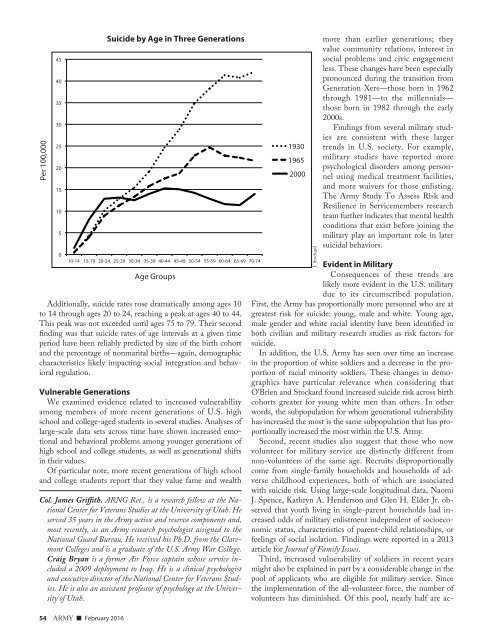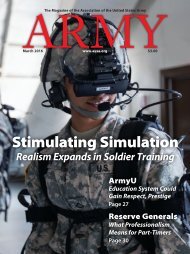Army - Kicking Tires On Jltv
Create successful ePaper yourself
Turn your PDF publications into a flip-book with our unique Google optimized e-Paper software.
Per 100,000<br />
45<br />
40<br />
35<br />
30<br />
25<br />
20<br />
15<br />
10<br />
5<br />
0<br />
Suicide by Age in Three Generations<br />
10-14 15-19 20-24 25-29 30-34 35-39 40-44 45-49 50-54 55-59 60-64 65-69 70-74<br />
Age Groups<br />
Additionally, suicide rates rose dramatically among ages 10<br />
to 14 through ages 20 to 24, reaching a peak at ages 40 to 44.<br />
This peak was not exceeded until ages 75 to 79. Their second<br />
finding was that suicide rates of age intervals at a given time<br />
period have been reliably predicted by size of the birth cohort<br />
and the percentage of nonmarital births—again, demographic<br />
characteristics likely impacting social integration and behavioral<br />
regulation.<br />
Vulnerable Generations<br />
We examined evidence related to increased vulnerability<br />
among members of more recent generations of U.S. high<br />
school and college-aged students in several studies. Analyses of<br />
large-scale data sets across time have shown increased emotional<br />
and behavioral problems among younger generations of<br />
high school and college students, as well as generational shifts<br />
in their values.<br />
Of particular note, more recent generations of high school<br />
and college students report that they value fame and wealth<br />
Col. James Griffith, ARNG Ret., is a research fellow at the National<br />
Center for Veterans Studies at the University of Utah. He<br />
served 35 years in the <strong>Army</strong> active and reserve components and,<br />
most recently, as an <strong>Army</strong> research psychologist assigned to the<br />
National Guard Bureau. He received his Ph.D. from the Claremont<br />
Colleges and is a graduate of the U.S. <strong>Army</strong> War College.<br />
Craig Bryan is a former Air Force captain whose service included<br />
a 2009 deployment to Iraq. He is a clinical psychologist<br />
and executive director of the National Center for Veterans Studies.<br />
He is also an assistant professor of psychology at the University<br />
of Utah.<br />
1930<br />
1965<br />
2000<br />
J. Stockard<br />
more than earlier generations; they<br />
value community relations, interest in<br />
social problems and civic engagement<br />
less. These changes have been especially<br />
pronounced during the transition from<br />
Generation Xers—those born in 1962<br />
through 1981—to the millennials—<br />
those born in 1982 through the early<br />
2000s.<br />
Findings from several military studies<br />
are consistent with these larger<br />
trends in U.S. society. For example,<br />
military studies have reported more<br />
psychological disorders among personnel<br />
using medical treatment facilities,<br />
and more waivers for those enlisting.<br />
The <strong>Army</strong> Study To Assess Risk and<br />
Resilience in Servicemembers research<br />
team further indicates that mental health<br />
conditions that exist before joining the<br />
military play an important role in later<br />
suicidal behaviors.<br />
Evident in Military<br />
Consequences of these trends are<br />
likely more evident in the U.S. military<br />
due to its circumscribed population.<br />
First, the <strong>Army</strong> has proportionally more personnel who are at<br />
greatest risk for suicide: young, male and white. Young age,<br />
male gender and white racial identity have been identified in<br />
both civilian and military research studies as risk factors for<br />
suicide.<br />
In addition, the U.S. <strong>Army</strong> has seen over time an increase<br />
in the proportion of white soldiers and a decrease in the proportion<br />
of racial minority soldiers. These changes in demographics<br />
have particular relevance when considering that<br />
O’Brien and Stockard found increased suicide risk across birth<br />
cohorts greater for young white men than others. In other<br />
words, the subpopulation for whom generational vulnerability<br />
has increased the most is the same subpopulation that has proportionally<br />
increased the most within the U.S. <strong>Army</strong>.<br />
Second, recent studies also suggest that those who now<br />
volunteer for military service are distinctly different from<br />
non-volunteers of the same age. Recruits disproportionally<br />
come from single-family households and households of adverse<br />
childhood experiences, both of which are associated<br />
with suicide risk. Using large-scale longitudinal data, Naomi<br />
J. Spence, Kathryn A. Henderson and Glen H. Elder Jr. observed<br />
that youth living in single-parent households had increased<br />
odds of military enlistment independent of socioeconomic<br />
status, characteristics of parent-child relationships, or<br />
feelings of social isolation. Findings were reported in a 2013<br />
article for Journal of Family Issues.<br />
Third, increased vulnerability of soldiers in recent years<br />
might also be explained in part by a considerable change in the<br />
pool of applicants who are eligible for military service. Since<br />
the implementation of the all-volunteer force, the number of<br />
volunteers has diminished. Of this pool, nearly half are ac-<br />
54 ARMY ■ February 2016

















